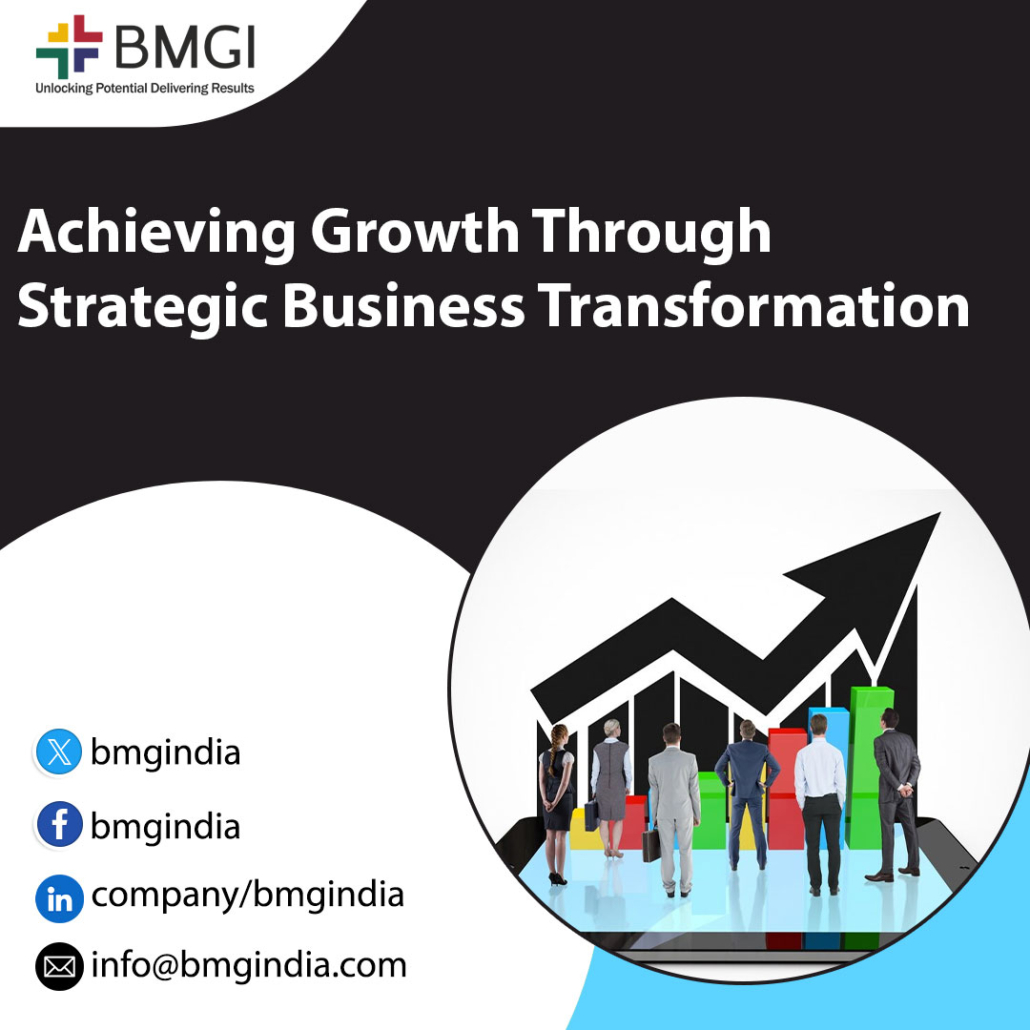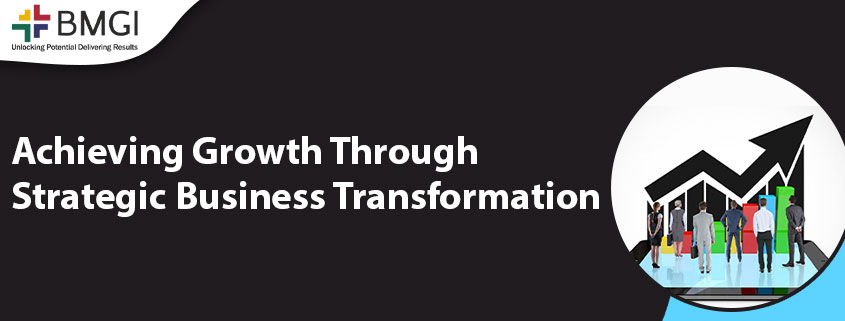Achieving Growth Through Strategic Business Transformation
For businesses to remain successful, they must constantly evolve. Growth is no longer just about expanding operations—it requires strategic business transformation that aligns processes, people, and technology with long-term objectives. Companies that fail to adapt risk inefficiencies, declining profitability, and missed market opportunities.

Strategic business transformation goes beyond short-term fixes and focuses on reshaping an organization’s core strategies to drive sustainable success. This article explores how businesses can achieve growth by embracing transformation through process optimization, strategy execution, and continuous improvement.
What is Strategic Business Transformation?
Strategic business transformation is a holistic process of rethinking and redesigning business models, operations, and strategies to improve efficiency, competitiveness, and scalability. It involves:
– Reevaluating business strategies to align with market demands and emerging trends.
– Optimizing operations to enhance productivity, reduce waste, and improve resource allocation.
– Leveraging technology for process automation, data-driven decision-making, and enhanced customer experiences.
– Fostering innovation to stay ahead of competitors and meet evolving customer needs.
The ultimate goal is to create an adaptable, future-ready organization that can respond to industry shifts while maintaining profitability and operational excellence.
Why is Strategic Business Transformation Critical for Growth?
Strategic business transformation is essential for growth as it enables companies to adapt to market changes, improve efficiency, and enhance customer experiences. With evolving technologies, regulatory shifts, and changing consumer preferences, businesses must stay ahead by refining strategies and operations. Outdated systems can hinder productivity, but transformation through process optimization and automation streamlines workflows, reducing costs and increasing efficiency. A customer-centric approach ensures businesses meet evolving demands, fostering loyalty and revenue growth. Additionally, transformation creates opportunities for new revenue streams by expanding into emerging markets and adopting innovative technologies. Ultimately, a well-executed transformation builds agility and resilience, allowing organizations to navigate disruptions and sustain long-term success.
Key Drivers of Business Transformation
1. Strategy Execution for Long-Term Growth
Many organizations have well-defined strategies but struggle with execution. Properly deploying a strategy ensures that every function within the business is aligned with overarching goals. Tools like Hoshin Kanri and the Balanced Scorecard help organizations bridge the gap between strategic planning and operational execution.
By refining strategic priorities, businesses can:
✔ Improve decision-making processes.
✔ Align teams and departments with organizational objectives.
✔ Ensure continuous tracking of performance against key business goals.
2. Process Optimization to Improve Efficiency
Business transformation requires eliminating inefficiencies and ensuring that workflows support growth objectives. Process optimization techniques such as Lean and Six Sigma help businesses:
✔ Identify and eliminate non-value-added activities.
✔ Reduce operational costs while maintaining quality.
✔ Improve resource allocation and workforce efficiency.
For example, a manufacturing company might use Lean principles to reduce production downtime, while a service-based organization could streamline customer onboarding processes.
3. Digital Transformation and Data-Driven Decision-Making
Technology is a cornerstone of modern business transformation. Organizations that integrate data analytics, artificial intelligence, and process automation gain a significant edge.
✔ Advanced business analytics helps identify trends and uncover new growth opportunities.
✔ Real-time data enables better decision-making and proactive risk management.
✔ Digital tools streamline operations and enhance customer engagement.
For instance, a retail company might use AI-powered chatbots to improve customer service, while a logistics firm could implement IoT to optimize supply chain operations.
4. Innovation for Competitive Advantage
Sustained growth requires continuous innovation in both products and processes. Companies that implement structured innovation methods like TRIZ and Design for Six Sigma (DFSS) can:
✔ Improve product development cycles.
✔ Enhance customer experience with high-quality, market-driven solutions.
✔ Drive industry leadership by adopting disruptive technologies.
By fostering a culture of innovation, organizations stay ahead of the competition while meeting evolving customer expectations.
5. Organizational Change Management
A successful transformation requires employee engagement and leadership commitment. Organizations must ensure that change is effectively communicated and adopted across all levels.
✔ Clear leadership vision and commitment.
✔ Structured training programs to upskill employees.
✔ A company-wide culture that embraces change and continuous improvement.
Without proper change management, even the most well-designed transformation strategies may fail.
How Management Consulting Firms Can Help
Strategic business transformation is essential for organizations seeking sustainable growth, operational efficiency, and long-term success. In an ever-evolving market, businesses must continuously adapt by optimizing internal processes, aligning strategies with execution, and fostering a culture of continuous improvement. However, transformation is not just about making short-term adjustments—it requires a structured, data-driven approach that ensures measurable and lasting impact. This is where management consulting firms play a crucial role, providing expert guidance, industry-proven methodologies, and customized solutions to help businesses streamline operations, reduce costs, and drive innovation.
By leveraging frameworks such as Lean, Six Sigma, TRIZ, Hoshin Kanri, and Balanced Scorecard, consulting firms help organizations identify inefficiencies, enhance decision-making, and implement process improvements that lead to tangible results. They assist in strategy deployment, change management, and performance optimization, ensuring transformation efforts are integrated across all levels of the business. With expertise in strategy execution, process excellence, and operational restructuring, consulting firms empower organizations to navigate change effectively, optimize resource utilization, and achieve long-term business success.
Real-World Examples of Successful Transformation
- Microsoft: Under Satya Nadella’s leadership, Microsoft transformed from a software-centric company to a cloud computing powerhouse, driving significant growth and innovation.
- Netflix: Netflix transitioned from a DVD rental service to a global streaming giant, revolutionizing the entertainment industry.
- Walmart: Walmart embraced digital transformation by investing in e-commerce and supply chain automation, enabling it to compete with online retailers like Amazon.
Conclusion
Achieving growth through strategic business transformation is a multi-faceted approach that requires strategy execution, process optimization, digital transformation, and a strong focus on innovation. Companies that invest in structured transformation initiatives can improve efficiency, increase market share, and drive long-term success.
By adopting proven methodologies and aligning strategies with execution, organizations can navigate change effectively and unlock sustainable business growth.
Source: https://bmgindia.nethouse.ru/articles/achieving-growth-through-strategic-business-transformation


Leave a Reply
Want to join the discussion?Feel free to contribute!